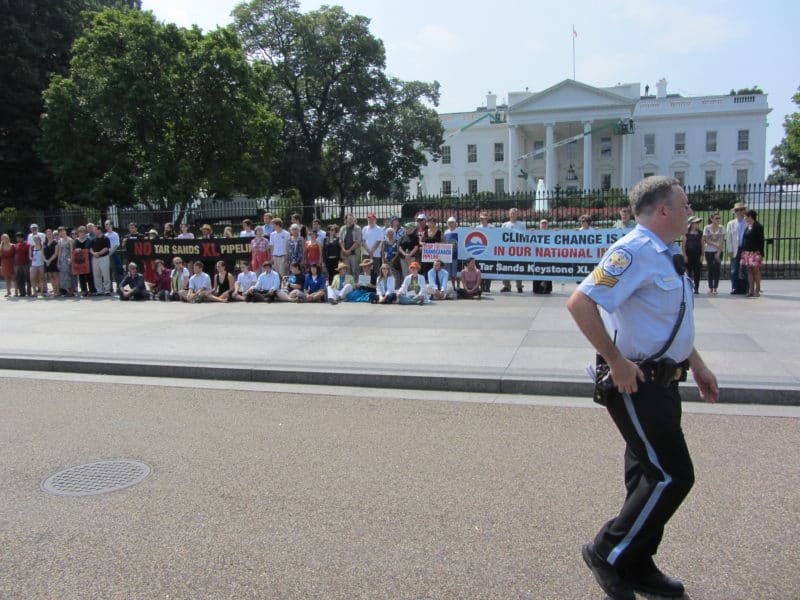On November 6, eco activist and Beacon Press editor Alexis Rizzuto was part of the Tar Sands Action protest in Washington, D.C. She sat down with blog editor Jessica Bennett to discuss the protest and its impact.
Jessica Bennett: What was the protest about?
Alexis Rizzuto: It was to tell Obama not to approve the Keystone XL pipeline in Alberta, Canada, proposed by TransCanada corporation to run from Canada to Texas. They are cutting down the boreal forest in Alberta and turning it into a toxic wasteland to get at the oil up there. Which is a hugely intensive use of energy—you have to burn a lot of carbon to get the oil out, and you also have to use a lot of water to extract it and then to refine it. Then the heavy oil is sent through these pipelines.
They had a former union pipeline worker there who used to work for Keystone, John Bolenbaugh. He said that the Keystone 1 pipeline—a smaller one that they had already put in—they had promised that it would only have one leak only every ten to twelve years. In the first year, they had twelve leaks. Because the stuff they’re putting in there, called bitumen, is like sandpaper inside the pipes, and it just wears through. Of course they haven’t cleaned it up yet, just covered it up, and people are getting sick.
They are proposing to put this pipeline through Nebraska, Montana, South Dakota, Kansas, Oklahoma, and Texas. Through wilderness, over waterways, and over the Ogallala aquifer, which provides fresh water for millions of people. So it’s an energy-intensive extractive process, the pipeline will certainly leak, and then when it gets to Texas, it will be refined and we’ll have more toxic waste down there, and it will use up a lot of water that Texas does not have. Maude Barlow said it takes 2-3 barrels of water per unit of tar sand oil. And in the end, it will just be exported, so we can’t really say that it’s going to help give the U.S. any energy independence.
Most importantly, the message is that we should not be using energy and contaminating the environment to continue our dependence on fossil fuel (as we are with fracking for gas and mountaintop removal mining for coal) when we should instead be putting our federal resources behind developing our alternative energy sector—as we are behind most other industrialized countries in doing.
Jessica Bennett: How many people were there?
Alexis Rizzuto: Twelve thousand people showed up for this protest. The idea was to have us encircle the White House completely. Bill McKibben, who was the organizer and emcee, said that he was originally thinking that in order to get all the way around the White House, we were going to have to stretch out our arms to try to touch each other. But in fact the circle around the White House was three people deep, and he said this had not been done since Viet Nam.
Jessica Bennett:: What types of people did you see there?
Alexis Rizzuto: There were little kids, college kids, parents, older people, a great diversity of age and of ethnicities. Labor leaders, Nebraskan farmers, Native Americans, even several Army officers in full dress came out to support us. (One of them was Don’t Ask, Don’t Tell activist Lt. Dan Choi.) The group that I was marching with happened to have some people with great voices, so we were singing, If I Had a Hammer, in harmony. The speakers were powerful. They had Gerald Amos, a leader from the First Nations in Canada, author Maud Barlow, and John Adams, former director of the NRDC, who is our own author. Reverend Jim Wallis, he really got people fired up! Van Jones sent a statement, calling for us to support the president when he’s right and oppose him when he’s wrong. And calling for us to oppose this with civil disobedience if it goes through. I think most of us would be ready to stand in front of bulldozers.
There were three people dressed up like polar bears. And someone had a huge beach ball that looked like a globe, and a sign that said “Occupy Earth. ”
One of our chants was, “Stop the Pipeline. Yes we can! ” Because Obama asked us to be the change, so we were like, “Here we are, dude. Can you hear us now? ”
Jessica Bennett: The Obama administration pushed back the decision on the pipeline permit until after the next election, and TransCanada announced that it plans to reroute the pipeline to avoid the Sand Hills and the Ogallala Aquifer. Is this a victory?
Alexis Rizzuto: Yes, it is a victory in that Obama has sent the project back for further environmental study, which will take over a year. The delay—and a more honest, independent assessment than was done before—will most likely kill the project. So people are considering this a win in the U.S. And I am glad that Obama acted as the leader we elected him to be.
However, the tar sands are still being extracted in Alberta, and TransCanada is trying to build a pipeline west to the Pacific, to export the oil to China. Many Canadian tribes (whose land this will go through) are fighting it.
So, we need to support the Canadian efforts against pipelines from the tar sands to the Pacific, however we can. Eva Saulitis sent me a list of organizations working on the issue, including dogwoodinitiative.org and ecojustice.ca.
This post originally appeared at BeaconBroadside.com.
